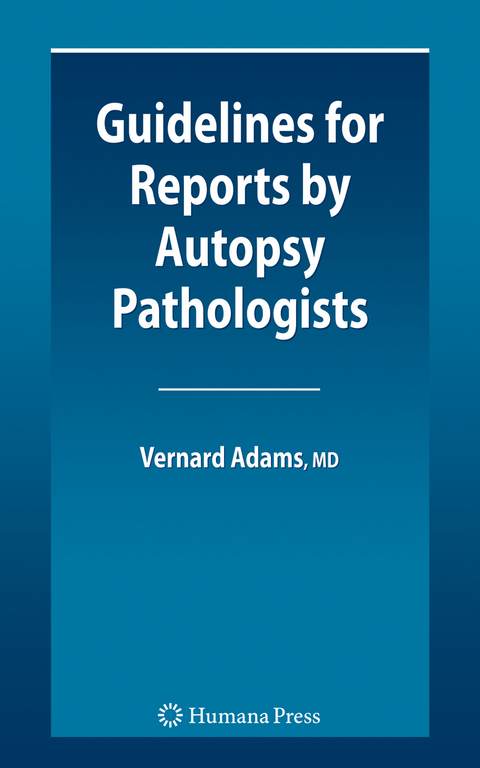
Guidelines for Reports by Autopsy Pathologists
Humana Press Inc. (Verlag)
978-1-61737-900-0 (ISBN)
Preface.- Acknowledgement.- Part I. Autopsy protocol.- Purpose, structure, and organization.- Purpose.- Structure.- Organization.- Measurements.- Diagnostic terms.- External Examination.- Inventory of parts.- Clothing and surface evidence.- Identifying Features.- Signs of death.- Organization of external findings.- Therapy.- Organ and tissue dnation.- Wounds by type.- General organization.- Outside-in.- Paragraphs.- Impact wounds.- Blade wounds.- Hanging.- Firearm wounds.- Burns and fire deaths.- Wounds by organ.- Measurements.- Bones: General.- Skull and Dura.- Ribs.- Long bones and pelvis.- Vertebrae.- Ligaments, joints and muscle.- Body cavities.- Aortic lacerations.- Heart.- Central nervous system.- Lungs.- Liver.- Spleen.- Internal examination.- Autopsy procedures.- Wounds, therapy, and donations.- Body cavities.- Heart and great vessels.- lungs.- Liver, bile ducts, gallbladder and pancreas.- Reticuloendothelial system.- Genitourinary system.- Endocrine organs.- Digestive organs.- Musculoskeletal system.- Neck.- Head.- Tumors.- Part II. Opinion reports.- The logic of opinion formation.- Definitions of cause, mechanism, and manner.- Global approach.- Synthesis of mechanism, cause, and manner.- Competing diseases and injuries.- Degree of certainty.- Dignosis in tabular format.- Purpose.- Structure.- Diagnosis or finding?- What to include.- Cause of death as diagnosis.- Completeness and etiologic specificity.- Diagnosis in Narrative Format: The Summary and opinion report.- Purpose.- Structure.- History.- Autopsy Findings.- Opinions.- Part III. Other reports.- Ancillary laboratory reports.- Integration and investigation by pathologist.- Purpose.- Structure.- Case identification.- Background Information.- Environment.- Body.- Actions Taken.- Animal bones.- Purpose.- Structure.- Content.- Part IV. Style.- Construction.- Sentences.- Paragraphs.- Abbreviations.- Parentheses.- Adjectives.- Verbs.- Natural indexing.- Dictating to avoid editing.- Attorneys’ rules ofconstruction.- Inserting minor opinions.- Word Order.- Terminology.- Anatomical Terminology.- Latin and Greek.- Slang.- Brand names.- General Terminology.
| Erscheint lt. Verlag | 5.11.2010 |
|---|---|
| Zusatzinfo | XV, 128 p. |
| Verlagsort | Totowa, NJ |
| Sprache | englisch |
| Maße | 155 x 235 mm |
| Themenwelt | Medizin / Pharmazie ► Medizinische Fachgebiete |
| Studium ► 2. Studienabschnitt (Klinik) ► Pathologie | |
| Studium ► 2. Studienabschnitt (Klinik) ► Rechtsmedizin | |
| Studium ► Querschnittsbereiche ► Prävention / Gesundheitsförderung | |
| Recht / Steuern ► Strafrecht ► Kriminologie | |
| ISBN-10 | 1-61737-900-X / 161737900X |
| ISBN-13 | 978-1-61737-900-0 / 9781617379000 |
| Zustand | Neuware |
| Haben Sie eine Frage zum Produkt? |
aus dem Bereich


